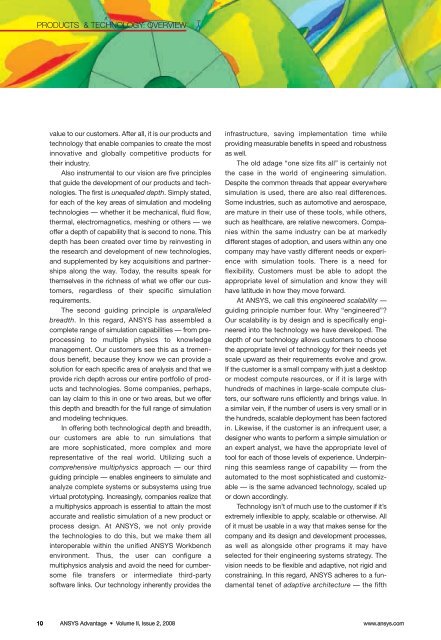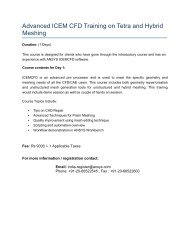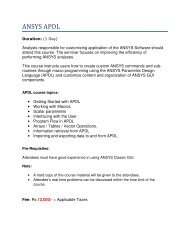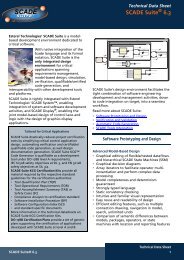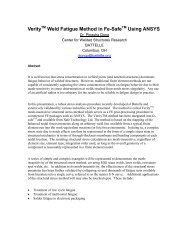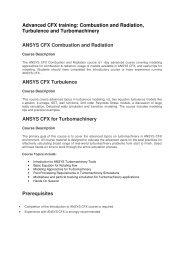Simulation - ANSYS
Simulation - ANSYS
Simulation - ANSYS
You also want an ePaper? Increase the reach of your titles
YUMPU automatically turns print PDFs into web optimized ePapers that Google loves.
PRODUCTS & TECHNOLOGY: OVERVIEW<br />
value to our customers. After all, it is our products and<br />
technology that enable companies to create the most<br />
innovative and globally competitive products for<br />
their industry.<br />
Also instrumental to our vision are five principles<br />
that guide the development of our products and technologies.<br />
The first is unequalled depth. Simply stated,<br />
for each of the key areas of simulation and modeling<br />
technologies — whether it be mechanical, fluid flow,<br />
thermal, electromagnetics, meshing or others — we<br />
offer a depth of capability that is second to none. This<br />
depth has been created over time by reinvesting in<br />
the research and development of new technologies,<br />
and supplemented by key acquisitions and partnerships<br />
along the way. Today, the results speak for<br />
themselves in the richness of what we offer our customers,<br />
regardless of their specific simulation<br />
requirements.<br />
The second guiding principle is unparalleled<br />
breadth. In this regard, <strong>ANSYS</strong> has assembled a<br />
complete range of simulation capabilities — from preprocessing<br />
to multiple physics to knowledge<br />
management. Our customers see this as a tremendous<br />
benefit, because they know we can provide a<br />
solution for each specific area of analysis and that we<br />
provide rich depth across our entire portfolio of products<br />
and technologies. Some companies, perhaps,<br />
can lay claim to this in one or two areas, but we offer<br />
this depth and breadth for the full range of simulation<br />
and modeling techniques.<br />
In offering both technological depth and breadth,<br />
our customers are able to run simulations that<br />
are more sophisticated, more complex and more<br />
representative of the real world. Utilizing such a<br />
comprehensive multiphysics approach — our third<br />
guiding principle — enables engineers to simulate and<br />
analyze complete systems or subsystems using true<br />
virtual prototyping. Increasingly, companies realize that<br />
a multiphysics approach is essential to attain the most<br />
accurate and realistic simulation of a new product or<br />
process design. At <strong>ANSYS</strong>, we not only provide<br />
the technologies to do this, but we make them all<br />
interoperable within the unified <strong>ANSYS</strong> Workbench<br />
environment. Thus, the user can configure a<br />
multiphysics analysis and avoid the need for cumbersome<br />
file transfers or intermediate third-party<br />
software links. Our technology inherently provides the<br />
infrastructure, saving implementation time while<br />
providing measurable benefits in speed and robustness<br />
as well.<br />
The old adage “one size fits all” is certainly not<br />
the case in the world of engineering simulation.<br />
Despite the common threads that appear everywhere<br />
simulation is used, there are also real differences.<br />
Some industries, such as automotive and aerospace,<br />
are mature in their use of these tools, while others,<br />
such as healthcare, are relative newcomers. Companies<br />
within the same industry can be at markedly<br />
different stages of adoption, and users within any one<br />
company may have vastly different needs or experience<br />
with simulation tools. There is a need for<br />
flexibility. Customers must be able to adopt the<br />
appropriate level of simulation and know they will<br />
have latitude in how they move forward.<br />
At <strong>ANSYS</strong>, we call this engineered scalability —<br />
guiding principle number four. Why “engineered”?<br />
Our scalability is by design and is specifically engineered<br />
into the technology we have developed. The<br />
depth of our technology allows customers to choose<br />
the appropriate level of technology for their needs yet<br />
scale upward as their requirements evolve and grow.<br />
If the customer is a small company with just a desktop<br />
or modest compute resources, or if it is large with<br />
hundreds of machines in large-scale compute clusters,<br />
our software runs efficiently and brings value. In<br />
a similar vein, if the number of users is very small or in<br />
the hundreds, scalable deployment has been factored<br />
in. Likewise, if the customer is an infrequent user, a<br />
designer who wants to perform a simple simulation or<br />
an expert analyst, we have the appropriate level of<br />
tool for each of those levels of experience. Underpinning<br />
this seamless range of capability — from the<br />
automated to the most sophisticated and customizable<br />
— is the same advanced technology, scaled up<br />
or down accordingly.<br />
Technology isn’t of much use to the customer if it’s<br />
extremely inflexible to apply, scalable or otherwise. All<br />
of it must be usable in a way that makes sense for the<br />
company and its design and development processes,<br />
as well as alongside other programs it may have<br />
selected for their engineering systems strategy. The<br />
vision needs to be flexible and adaptive, not rigid and<br />
constraining. In this regard, <strong>ANSYS</strong> adheres to a fundamental<br />
tenet of adaptive architecture — the fifth<br />
10 <strong>ANSYS</strong> <strong>ANSYS</strong> Advantage Advantage • • Volume Volume II, II, Issue Issue 2, 1, 2008<br />
2008<br />
www.ansys.com


